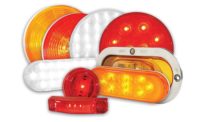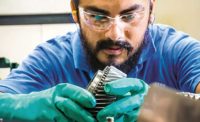The door latch on a vehicle doesn’t do much. It doesn’t power the vehicle. It doesn’t aid in handling or braking. But, of course, it’s vital to the safety and security of the vehicle’s occupants. And, no company has been making latches better over the years than Kiekert AG.
In its 160-year history, Kiekert has produced more than 1.9 billion latches for automotive OEMs around the globe. In fact, every third car worldwide has locking systems based on a Kiekert design. Headquartered in Heiligenhaus, Germany, the company tallied sales of $1 billion last year. It employs some 6,500 people worldwide at six R&D centers, three sales centers and eight production sites, including Wixom, MI.
The company’s product portfolio includes locking systems, such as side-door latches, latch modules, rear-compartment and hood latches and a broad range of actuators for side doors, sliding doors, deck lids and various interior components. Kiekert’s core product, the side-door latch, covers a range of functions. These include groundbreaking inventions like central locking, electromechanical power closing, electrical child safety and “Active Inertia,” a weight- and space-saving feature that functionally decouples the latch from the outer door handle in case of a crash. This feature ensures that a door won’t fly open in the event of an accident.
Kiekert products can currently be found in more than 60 automotive brands worldwide. That sort of success doesn’t happen by accident. The company emphasizes R&D, and more than a third of its products are less than three years old.
Recently, we spoke with Guido Hanel, Ph.D., Kiekert’s chief operating officer, to talk about the automotive supplier business. Hanel has worked for Kiekert for more than 10 years. Prior to becoming COO, Hanel served as general manager of Kiekert’s factory in the Czech Republic and as executive vice president for program, planning and quality.
ASSEMBLY: Automotive locking systems have evolved from relatively simple mechanical devices to complex mechatronic products. Has that changed how locking systems are assembled?
Hanel: The biggest challenge is how to test these mechatronic parts. It’s not a question of assembly. It’s a question of testing functionality on the assembly line so that we don’t build scrap and we identify problems quickly.
ASSEMBLY: More than a third of Kiekert’s products are less than three years old. How does that influence the design of your assembly lines?
Hanel: If you compare a high-volume assembly line that is five or six years old with a new line, it would be hard to identify a difference. Our assembly system looks nearly the same. However, our end-of-line testers have more functionality. The data we are gathering during the assembly and test process has increased, and we plan to use that data to predict the long-term behavior of our products.
Our products are safety products. They must be very reliable, so 100 percent of our products are tested before they leave the factory. Both mechanical functions and electronic functions are tested on each latch. We test during assembly and at the end of the line. We do visual checks, tactile checks checks and poka-yoke, as well as electronic testing.
ASSEMBLY: All that testing must take a lot of time!
Hanel: On a high-volume assembly line with approximately 20 stations, 40 percent of those stations are purely for testing. That’s to make sure that the functionality of our latches is guaranteed.
There are two scenarios we never want to see happen: a car door opening accidently and a passenger falling out, or a car door failing to open in the event of an accident. So when we do failure mode and effects analysis, the severity of potential failure modes is always a very high number.
ASSEMBLY: Kiekert products can be found in more than 60 automotive brands worldwide. How do you meet the needs of such a varied customer base?
Hanel: OEM requirements are actually very similar. We work with development engineers from all the OEMs, so we know a lot about their vehicles. We know the forces exerted on our latches during normal use and also during accidents. We work with OEMs during the entire development phase, and our products must pass quality gates at every step.
When I started at Kiekert 10 years ago, a defect rate of 40 or 50 ppm [parts per million] was considered world class. Now, our customers want less than 10 ppm. That desire is not just confined to our established customers in North America, but also our new customers in China.
We have locations nearly everywhere in the world, including Japan, Korea, China, the United States, Mexico, Brazil, Germany, the Czech Republic and Russia. That’s important, because you want to speak in the right language to the customer to fully understand his requirements. When we go into a new country, we bring people on board from that country first. Then, we bring them to our headquarters in Germany for a year or two so they can learn the Kiekert way of doing things.
We need to be close to our customers. We don’t make off-the-shelf products. We develop specific products for each customer. To do that, you must have a very close relationship with the development guys on the other side.
ASSEMBLY: Last year, Kiekert announced that it would invest $1 million to expand its development and manufacturing center in Wixom, MI. Tell us more about that.
Hanel: First, we reinforced our product development capabilities at this location.
Also, the Wixom plant is small compared with other Kiekert plants. Our plants are huge. For example, our factory in the Czech Republic employs 3,000 people. So we are enlarging our capacities and capabilities at Wixom, especially for the modules we provide for customers in North America.
ASSEMBLY: What does a typical assembly line look like at Kiekert?
Hanel: A typical high-volume assembly line is a double-belt conveyor system. There’s a very clear material flow and a defined cycle time. Our typical cycle times are between 4.5 and 7 seconds. Also, it’s important to note that there’s no difference between assembly lines in Germany, the Czech Republic or China. They’re all on the same technical level.
We have spent a lot of effort over the past year to increase the rate of automation. A high-volume assembly line is a mixture of manual and automatic workstations. If you look at an assembly line for a latch, about 50 percent of the operations are automated. Not every process can be cost-effectively automated. For example, if you have to assemble some complicated springs, it may be possible to automate that, but in the end, if you look at the overall cost, it’s not a benefit for Kiekert. On the other hand, simple operations, such as precision dispensing of grease, are being done more and more with robots.
We have a comprehensive manufacturing engineering department. We develop and build most of our assembly equipment. We don’t make our own robots, of course, but we do all the integration and programming. We build all our end-of-line testers, as well. This enables us to react quickly to changes. If we have to add another function on the assembly line, we can do it in a short time with our own experts.
In the end, it’s our business. For us, it’s a question of knowledge building and knowledge saving. When you use outside suppliers, you have to teach them your assembly process and that knowledge could go directly to your competitors.
ASSEMBLY: What assembly technologies have made the biggest impact on your operations in the past decade or so?
Hanel: The first is not a pure assembly technology—it’s the control systems for our big assembly lines. For one customer, we produce four latches for one car, but each of those latches has variants for different markets—left-hand drive, right-hand drive, etc. So there’s actually a huge variety of products made on the same line. With today’s control systems, we are able to accomplish changeovers very quickly. That makes us much more flexible, and it has an overall beneficial effect on inventory.
Another technology that has made a difference for us, particularly in the past two years, is very small robots. They have become cheaper and more reliable, and this is opening up more possibilities to automate some assembly processes.
The next step for us will be to make better use of all the data we are gathering during assembly. This is part of Industry 4.0.
ASSEMBLY: What will all that data tell you?
Hanel: Prediction. For example, sometimes we have to measure free play in a joint after riveting. We are now working on a project that will enable us to predict the behavior of the product from that process data, and the initial results are very promising. During my university time, I dreamed of this possibility, and now technologies are emerging that will enable us to do that. If you can predict product behavior more precisely, you can reduce your testing efforts. We will be able to lower the cost of our products, with less investment. So data management, data handling, data prediction—these will be essential for the future.
ASSEMBLY: German companies are typically proactive about workforce development. What is Kiekert doing in that regard?
Hanel: When new people are hired for the assembly line, we test them to ensure they are capable of doing the work and then we systematically train them for several weeks. One thing we emphasize during training is that our products are vital to vehicle safety and that each worker’s job, no matter how small, is important.
On the white collar level, new managers at Kiekert work for one week on the assembly line to get a feel for production.




